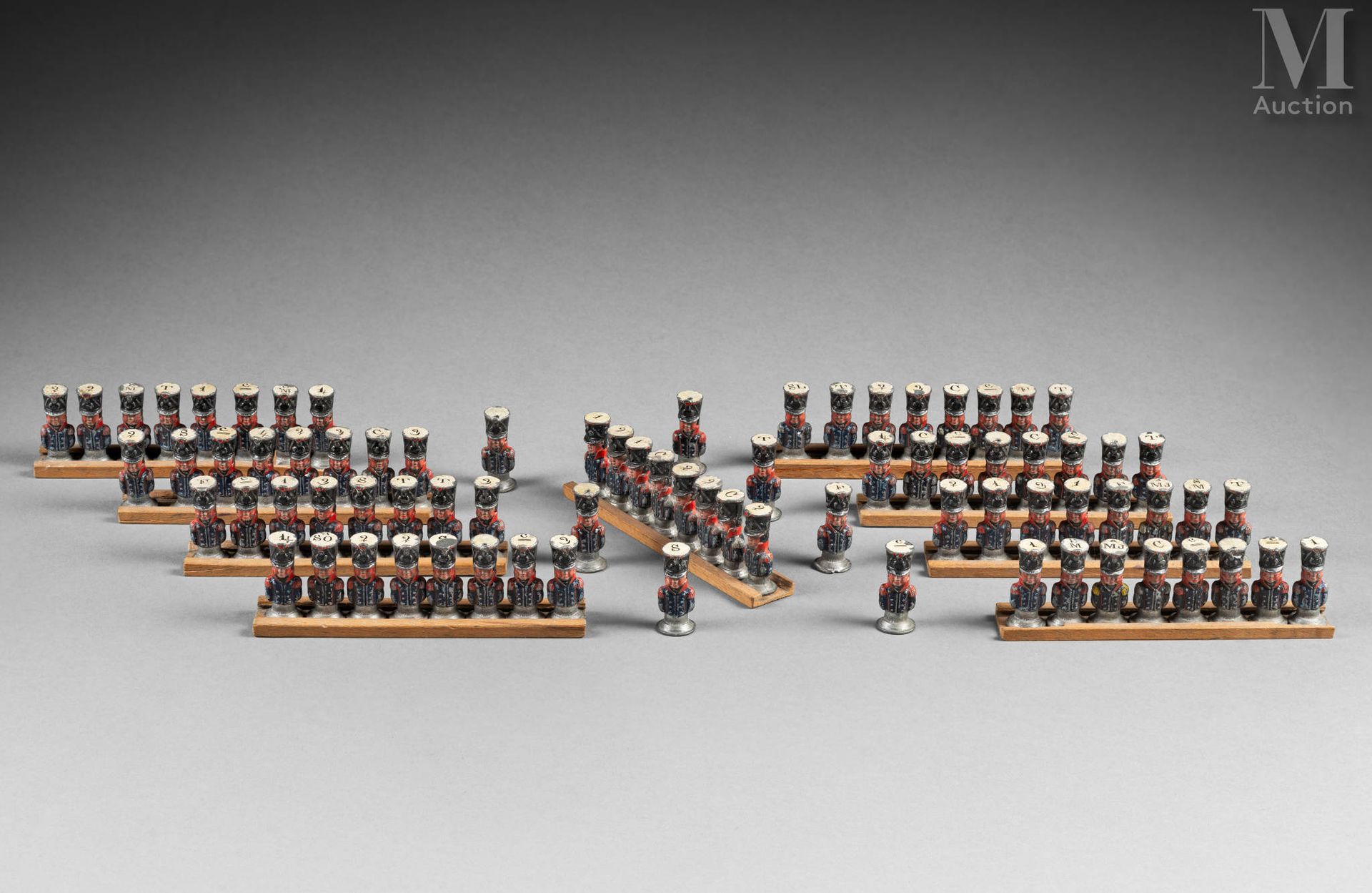Description
SOLDATS EN ÉTAIN DU MODÈLE DU JEU OFFERT AU ROI DE ROME
Rare set of 79 painted pewter toy soldiers (the term "lead" was erroneously retained by history), modeled after the 22nd Light Infantry Regiment presented to the King of Rome in 1812. Each depicted in bust form, on a pedestal, with rank or rank penciled into the shako, most with red epaulets, two officers with yellow epaulets. Presented in sets of eight on nine wooden retaining clips (seven are without their clips). Worn but in good condition. First Empire period, circa 1812-1814. H. 3.6 cm. Provenance - Probably Louis Nicolas DAVOUT, Duc d'Auerstaedt, Prince d'Eckmühl, Maréchal de l'Empire (1770-1823), for his children. - Probably collected by his son-in-law Achille-Pierre Félix, comte Vigier (1801-1868), at his château de Grand-Vaux (Savigny-sur-Orge), then by descent. - Henri Bruno Coursier (1897-1969), a diplomat who purchased the Château de Grand-Vaux before its destruction in 1958, along with some of its furniture, notably acquired at the sale of June 22-23-24, 1935 (Me Venot et Couturier). - Then to his grandson, the current owner. Related works - The complete 120-piece regiment of the 22e Léger with old traces of gilding, from the Roi de Rome, formerly sold at Coutau-Bégarie, July 9, 2004, lot 455 (sold for €178,710), is currently in the Bruno Ledoux collection. They came from the Empress Eugénie at the Tuileries. - Three pewter soldiers from another regiment, brought back from Austria by Madame Soufflot, sub-governor of the King of Rome, are kept at the Fondation Napoléon (inv. 905). - 95 soldiers on bars, Osenat sale, December 4, 2011, lot 194. - 8 soldiers on barrettes, Leclere sale, April 12, 2017, lot 77. - 14 soldiers on barrettes, Millon sale, June 25, 2019, lot 175. - 12 soldiers, Osenat sale, March 24, 2024, lot 140. History Only a few toy merchants were known in Paris under the Empire, such as Cacheleux, 116 rue Saint Denis, or Mittou, 81 rue Neuve des Petits Champs. The latter was the only one to bear the prestigious title of "Marchand de jouets des Enfants de la Famille Impériale et Royale". In 1812, Napoleon placed an order for two complete sets of 120 figures each, representing the regiments of the 21st and 22nd Legers, the first with the Empress Marie-Louise's figure, the second with the Emperor's figure. As this was the imperial couple's first birthday present to their son, the toy had to stand out from the other gifts offered by members of the imperial family and court. Goldsmith Jean-Baptiste Odiot was commissioned to goldplate each of the 240 small lead figurines, 36 mm high in the round, depicting a soldier's bust wearing a shako and carried on a pedestal. Ranks were indicated in black letters on the shakos, while the epaulettes of soldiers and non-commissioned officers were painted red, and those of officers yellow. Each set, known as a "demonstration" set, was set out on twelve ten-figure boards. Two years later, Marie-Louise offered her son another, larger set, found in a memoir by Mittou, dated January 15, 1814: "sold to S.M. L'Impératrice (...) 1 large box of pewter soldiers consisting of five cavalry regiments and five infantry regiments, all in good condition and complete". It was after the fall of the Empire that the little lead soldiers of the King of Rome were to experience the vicissitudes of history. To enable them to be transported from France to Austria and returned to L'Aiglon, while escaping Metternich's surveillance, the sets were painstakingly made up by a Nancy silversmith, André Grapin. The gold plating was completely scraped off, all imperial markings were removed and the whole set was repainted in the three colors of Marie-Louise's guard of honor in Parma: black, blue and red. During the Second Empire, some of the soldiers were returned to Napoleon III via the de Pierres family, related to the Metternichs. In September 1870, before fleeing the Tuileries, Empress Eugénie entrusted her first equerry, Baron de Pierres, with the complete set of the 22nd Léger. As for the soldiers of the 21st, to which the three figurines in the Fondation Napoléon belong, they were scattered among several hands. We don't know if all the King of Rome's pawns were gilded, but the few sets of non-gilded pewter soldiers that have appeared on the art market in recent years show that their use must have been more or less widespread among the Imperial Family's entourage. The Davout provenance of our set of 79 soldiers, the third most numerous to appear on the market, would lead us to believe that the only wire
220
SOLDATS EN ÉTAIN DU MODÈLE DU JEU OFFERT AU ROI DE ROME
